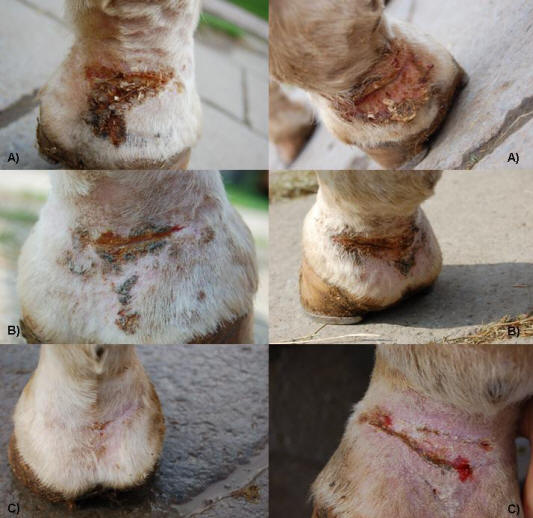 From: http://www.smartpakequine.com/health_and_nutrition/problems/scratches.aspx
From: http://www.smartpakequine.com/health_and_nutrition/problems/scratches.aspx
What is it?
Scratches is a relatively common skin disease of the heels and back of the pastern. Also known as “greasy heel,” “mud fever,” and “dew poisoning,” veterinarians may refer to it as pastern dermatitis or pastern folliculitis. Repeated wetting and drying of the skin in this area seems to lead to the condition rather than infection by one particular organism, although bacteria and fungi are usually involved. Early on, the heels and pastern may be reddened, warm, and ooze a small amount of yellowish, watery liquid (serum). As the condition progresses, hair is lost, the area becomes thickened, and hard crusts or scabs of serum form. The condition is painful to the touch and may even cause the horse to become lame.
What can be done about it?
A veterinarian should diagnose the condition so that other diseases can be ruled out and appropriate treatment started. All crusts, scabs and dead tissue must be removed before healing can begin but this must be done gently and with only mild soap, if needed. Avoid harsh scrubbing and chemicals. Hair may need to be clipped away from the area. Ointments that have been recommended for Scratches include antibiotics, antifungals, steroids and other medications but these should only be applied on the advice of a veterinarian and only on clean, dry skin.
What else do I need to know?
Standing in muddy paddocks, grazing in wet pastures, and frequent bathing all weaken the skinÕs natural protective barrier and set the horse up for Scratches. If the horse cannot be kept in a dry environment, then a light barrier cream such as petroleum jelly may be applied to the pastern and heels before exposure to wet. Horses with long leg hair or feathers may benefit from removal of this hair so that moisture and contaminants are not trapped against the skin.










